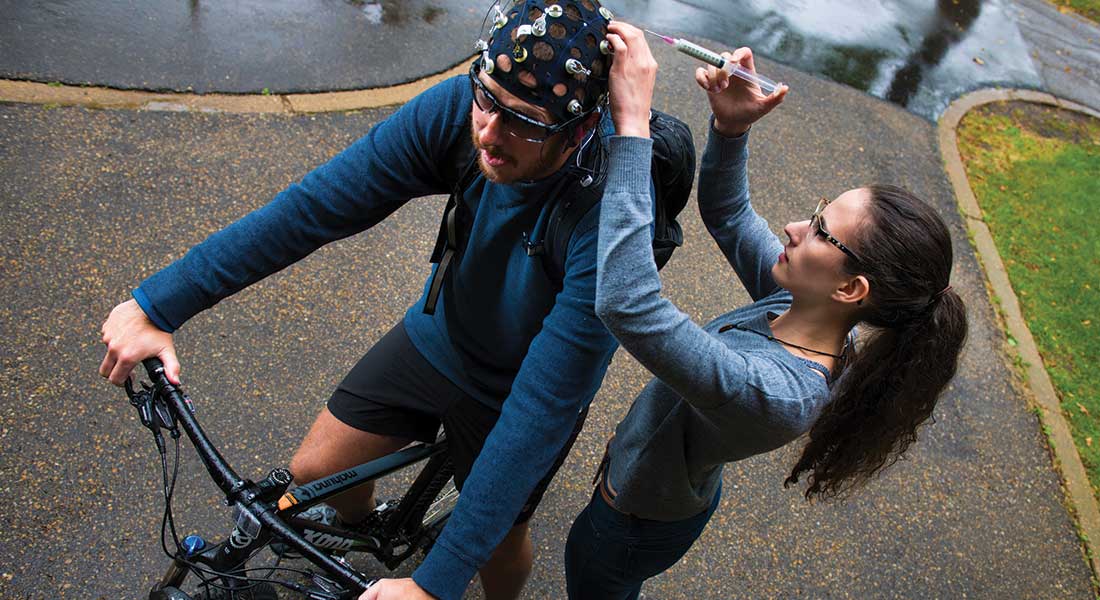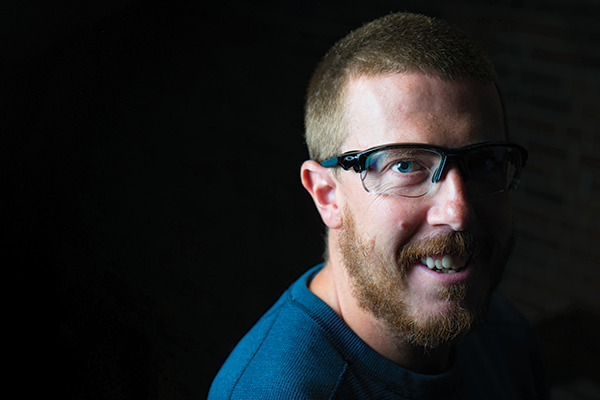
Neuroscientist Kyle Mathewson (left) and graduate student Joanna Scanlon gear up to take their research to the great outdoors.
Much of what we know about the human brain is oversimplified and, in some cases, possibly even wrong, suggests Kyle Mathewson, assistant professor of psychology. And it's because a great deal of neuroscience research is based on studying first-year undergraduate students sitting inside highly controlled laboratories, who happen to be participating in the study for credit in introductory psychology courses. Scary thought, right? The reasons behind it are many-from convenient samples to ethical concerns in targeting other populations, as well as clunky technology.
That's why the future of neuroscience is outside the lab, argues Mathewson, head of the Attention, Perception, and Performance (APP) Lab in the University of Alberta's Department of Psychology.
"If we want research to apply and contribute to all of society, we need to ensure that we understand how the brain works out in the world where humans actually live, work, and play," said Mathewson. "That means bringing research participants outside the lab and studying how our brains work in the real world."
In Mathewson's case, bringing studies outside the lab literally means taking them outside. For the last four years, Mathewson and his student research team in the APP lab have been working on researching the brain outdoors.
"We are already finding new phenomena that we can then take back inside the lab to isolate and investigate more precisely," explains Mathewson. "I think this is going to be a gold mine for researchers."
Safety and biking
The use of bicycles in Mathewson's lab is no accident. A passionate biker, Mathewson commutes to campus year-round and has been a large part of the push for safe bike lanes in Edmonton. He remains an advocate for improving accessibility to all forms of transportation in and around the University of Alberta and is a proud member of Paths for People, a non-profit organization focused on improving transportation in Alberta's capital city.
Interested in learning more about bike culture and the introduction of bike lanes in Edmonton? Check out the Urban and Regional Planning program offered through the Department of Earth and Atmospheric Sciences at UAlberta.
This is your brain outdoors.
One such study garnered international media attention this year, including a feature in Time magazine.
The study, conducted with graduate student Joanna Scanlon, had participants perform a simple cognitive task while riding a bike outdoors. Data were compared with data from the same task conducted on a stationary bike indoors. Results show that our brains process stimuli, like sounds and sights, differently when we are outdoors.
"Something about being outdoors changes brain activity," says Scanlon, who co-authored the study with Mathewson's guidance. "We noticed that brain activity associated with sensing and perceiving information was different when outdoors, which may indicate that the brain is compensating for environmental distractions."
"Your brain seems like it has to work harder when it's outside in the real world," adds Mathewson. While knowing that more distractions (such as traffic noise and nature) will cause us to shift our attention, understanding just how the brain works outdoors requires a great deal of further investigation.
But none of this groundbreaking research would have been possible without the portable technology that allowed the research team to get outside-another critical element in the future of neuroscience, according to Mathewson.
Siblings in science

Science runs in the Edmonton-based Mathewson family. Kyle's younger brother Kory Mathewson is in the midst of completing his PhD in the Department of Computing Science under the supervision of artificial intelligence (AI) experts Richard Sutton and Patrick Pilarski. In his research, Kory is exploring the ways in which interactive machine learning can make our lives easier, while also keeping our privacy safe. Kory is also the brain behind A.L.Ex-Artificial Language Experiment-an improv-performing robot that made headlines around the world last year for its performance art. Learn more about Kory's academic and recreational AI projects in the latest edition of the University of Alberta alumni magazine, New Trail.
Kory and Kyle have a third sibling in science. Though not at the University of Alberta, Keyfer Mathewson is working at Shopify and researching the use of machine learning in web and app development.
Together, the Mathewson brothers are beginning work on their startup company, PotentialAI, which brings together their unique expertise in human measurement and machine intelligence to unlock data's true potential.
Brain scanning: The next generation
In order to study the human brain, Mathewson, like many other neuroscientists, relies on an electroencephalogram, or EEG, to track and record brain activity. Traditional EEG machines are large and stationary-and are accompanied by a price tag of about $30,000. But soon, says Mathewson, these will be a thing of the past.
"We are taking what, 10 years ago, was in the hands of only graduate students and faculty researchers, and giving everyone at the university an opportunity to use it."
"Portable EEG systems are now easily accessible. You can even purchase them at Best Buy," says Mathewson. Best of all? The portable technology works anywhere, recording accurate data for the low price of $300 per machine, a fraction of the cost of traditional technology. "As we learn more and more about people's brains outside in the world, so too do the tools need to be more ubiquitous."
The applications for wearable technology are limitless in both research and teaching.
"Now, for a tenth of the cost, I can give my undergraduate students hands-on experience using this kind of technology," explains Mathewson. "We are taking what, 10 years ago, was in the hands of only graduate students and faculty researchers, and giving everyone at the university an opportunity to use it."
And, just like taking portable EEG devices into the classroom or outside, researchers can also bring the lab to new populations that were previously out of reach-think patients in long-term care, athletes at soccer practice, or climbers at the top of a mountain. "Most humans are adult workers, but very little neuroscience research addresses the average person going about their everyday life in their natural environment," explains Mathewson. This is a challenge that wearable, portable technology has the potential to overcome.
Yet another benefit of these inexpensive technologies is that curious minds all over the world who may not have had access before can now buy this technology at an affordable price-from researchers to high school students and everyone in between.
Mathewson is also working with engineers to develop the next generation of wearable electronics-sleeker, cheaper, and more accurate than what is currently available. "Currently, we're working on creating flexible, adhesive technology that can be worn on your forehead or behind your ears, making EEG technology even more portable than before," explains Mathewson.
The very near future
He also plans to bring his work full circle by developing a research program that brings realism back into the laboratory using virtual reality and video games.
"We continue working on basic science, trying to understand how the brain works," explains Mathewson. "One way that we can develop more realistic testing situations is using virtual reality. This way, we maintain complete control over what the subject sees, while still providing a three-dimensional, interactive space." It's the perfect combination of realism and control.
For Mathewson and his collaborators, the future of neuroscience is already here. Work continues on research both outside and inside the lab, identifying new phenomena and finding new and innovative ways to isolate and investigate them, with a focus on the development and use of wearable EEG technology we can all use.
